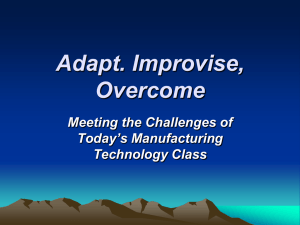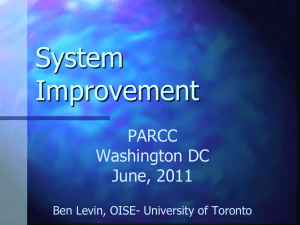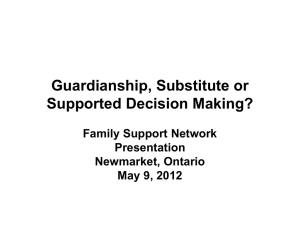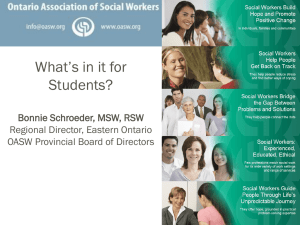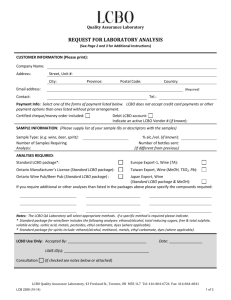McROBERT PRESENTATION: Slides 11-26 cover
advertisement
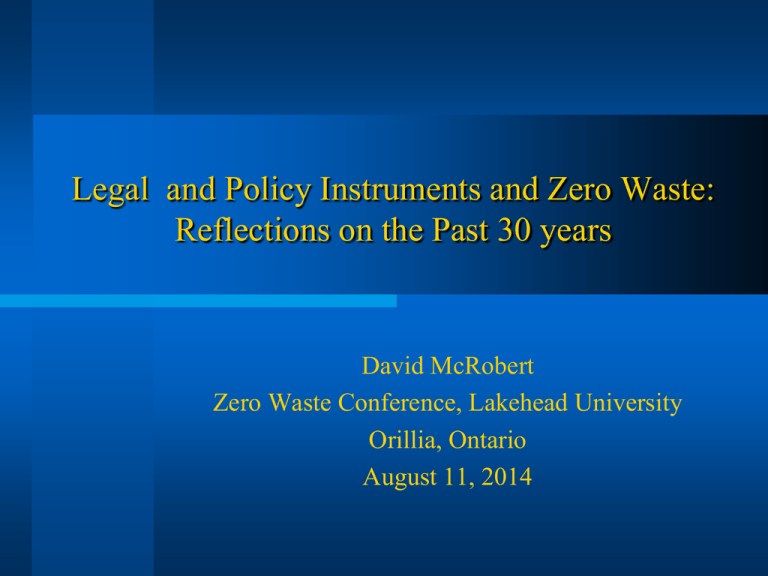
Legal and Policy Instruments and Zero Waste: Reflections on the Past 30 years David McRobert Zero Waste Conference, Lakehead University Orillia, Ontario August 11, 2014 “Garbage” Lawyer Worked for 16 years at the Environmental Commissioner of Ontario Part-time professor at FES, York, 1994-2009 Became fascinated with waste working as a bus boy in 1975 Worked as waste and climate change campaigner at Pollution Probe, 1990-91 Strong connections between two areas; e.g. climate change crisis shows atmosphere has become the great garbage dump in the sky At MOE worked on 3Rs regs. and enabling law Overview Object of the study and Method Policy Context Ontario Blue Box Deal Performance of the BB System and various consequences How to improve the situation Summary Object of the study The object of the study is to analyse changes in public policy related to waste diversion in the past 25 years. To conserve time the focus of this presentation will be on Ontario examples What is law reform about? Legal change is not the same as social change; we must change hearts and minds as well as laws otherwise the reforms do not take hold. This is hard work! Similarly, good laws start with good meta-policies that are coherent and durable- must be integrated What are metapolicies?? A metapolicy - otherwise known as a ‘policy on policies’ – provides a framework that sets out to define the range of compliance documents (e.g. regulations, policies, procedures, protocols) and establish a classification system which groups them (e.g. financial, information technology). More on metapolicies In addition, it identifies and describes the processes by which the compliance documents are developed, reviewed and made available to stakeholders. Metapolicy – Overarching Policies – Sub-policies; Laws; Regs; Guidelines; project approvals Metapolicies underpin laws Values and long term sustainability goals must inform the core metapolicies underpinning laws Take a specific challenge e.g. e-waste, wet waste, and work on Meta-policy Promoting positive law reform How can we promote positive law reform? (hint: with good meta-policies) In short, good process plus good content, leads to positive law reform Examples; Pay Equity, Gay Rights, etc. Waste Reduction Act will likely become law in Ontario but process was poor and result seems highly questionable What is the current metapolicy? Post-industrial capitalism, supercharged by Developing Nation (China, India, etc.) desire to sell us plastic junk Waste generation assumed and facilitated by relatively cheap energy Goods shipped hither and yon, contributing to climate change Current metapolicy Repair of products, clothing, etc. discouraged by manufacturers and retailers such as Walmart, Target and Costco E.g. Optical retailers at Loblaw’s Superstores “unable” (according to management) to obtain replacement arms for damaged eyeglasses after 1824 months Guilt relief North Americans ship many bicycles in disrepair to Cuba instead of refurbishing them here. In Sweden and other European nations, bikes now are being repaired Similarly we ship eyeglasses Undermines development of local capacity and true sustainability Consequences (1) Skills in repair businesses lost Possibility of strengthening local economies undermined Scrap metal and plastic dealers are thriving in small communities In Peterborough, hoards of men collecting welfare drive around in trucks scooping up marketable wastes Consequences (2) Waste generation, energy consumption pollution, CO2, etc. are increasing Most consumers don’t understand it is in their best interests to buy durable and repairable products. Some do; hence the popularity of well built cars in the past two decades Consumers and government are failing to deliver vital signals to market But Query … Does Walmart or big business really care? Selling disposable junk is their business model Similalrly local government waste management and recycling programs have enabled the continued distribution of throwaway products because of lack of EPR laws by senior levels of government Zero waste is a metapolicy Zero waste is a meta-policy, a path, a direction, a target; it’s a process, a way of thinking, a vision See Paul Connett’s excellent 2013 book, The Zero Waste Solution It’s Not Garbage Coalition Based out of Pollution Probe 1988-1992 and its members included CELA, Greenpeace, TEA, etc. Goal was zero waste for disposal Received tens of thousands in participant funding for IWA process in 1993-1994. Waste Reduction in Ontario See David McRobert et al., Five Years of Failure on Waste Reduction in Ontario (August 1990); Published by Pollution Probe Led in part to election of NDP government, banning of incineration and long distance export of garbage in 1991 Waste Reduction in Ontario Impetus for establishment of the WRO at MOE (1991-1994) Impetus for quick enactment of the Waste Management Act (1992), formation of the Interim Waste Authority in 1991 and the passage of the 3Rs regs in March 1994 Also: funding to RCO for 3Rs education and social marketing (cut in 1995) Design for Sustainability Design for Sustainability: Products should be made for a prolonged life and capable of easy disassembly and repair Packaging should be designed for reuse; Too many products are designed to be thrown away. Redesigning and managing products to be repairable Getting to Design for Disassembly Redesign requires collective responsibility by: individuals communities industries professionals politicians How do we get to Zero Waste? Decision makers need to work with the public to find solutions Recommending better industrial designs to industry on packaging and products Getting to zero Best practices for waste reduction and avoidance strategies from around the world – decision makers and businesses Redesign incorporated into the 3 R’s (fourth R) udy Notes – Product Stewardship Issues Related to Vacuum Cleaner and Small Appliance Repair in th By David McRobert and Meghan Robinson 1992 reforms to Ontario EPA In 1992 while working at the WRO of MOE I helped to draft provisions (contained in the Waste Mgt Act, 1992) that amended the EPA that allowed MOE to ban or regulate products that “posed waste management problems” We intended to target disposable diapers, tetrapaks (and other multimaterial packaging) Products and services that pose waste problems circa 2014 Obvious culprits remain: Disposable diapers, razors, cameras, smart phones and other e-waste, etc. Less obvious: advertising industry, politicians, Cdn. Senators, Toronto Maple Laughs, etc udy Notes – Product Stewardship Issues Related to Vacuum Cleaner and Small Appliance Repair in th By David McRobert and Meghan Robinson Case Study 1 – Vacuum Cleaners See separate draft hand out Case Study Notes – Product Stewardship Issues Related to Vacuum Cleaner and Small Appliance Repair in the 2010s By David McRobert and Meghan Robinson, August 8, 2014 Case Study 2: the BB System See David McRobert, My Municipal Recycling System Made me Fat and Sick (June 2012, available on Amazon) See also blog posts for Solid Waste and Recycling Magazine See www.davidmcrobert.ca Method and Methodology Nothing as practical as a good theory. The theoretical framework I use is ecological history, the approach I developed in 1983 for my Master’s work at the Faculty of Environmental Studies for his MES degree (1984). The analytical method is informed by the work of economic historians such as Harold Innis and the Annales school Approach to analysis To locate environmental and related waste policy in the context of social, technological and economic changes that have taken place in the past century Focus on development of the Blue Box system (BBS) in Ontario Examine whether there was evidence of regulatory capture of Ontario MOE Previous work Ontario's Blue Box System: A Case Study of Government's Role in the Technological Change Process, 1970-1991 Extracted from: David McRobert, Labour Relations, Technological Change and Sustainability: Resolving the Structural Issues. Osgoode Hall Law School, York University, October 1994. http://www.lacieg2s.ca/public/law/bluebox.htm Used Materials Economy, pre 1900 Prior to 1900s, trash or MSW was not the norm in cities With goods and money scarce, everything possible was recycled or reused. See S. Strasser, Waste and Want (1999) Deposits on used containers became the norm because they were perceived as so valuable Industrial Change For decades, energy and raw materials have been perceived by North Americans as cheap, labour as expensive In part this was because of large government subsidies to resource extraction industries, especially to oil and gas, mining and forestry Some marxist critics such as Drache, Glasbeek and Panitch have argued this was a deliberate economic policy in some developed nations to reduce bargaining power of labour unions Subsidies and Resource Industries Subsidies to resource industries were: 1. were intended to maintain legitimacy of NA urban industrial growth model; 2. helped facilitate tech change in workplaces because management has legal control of technology, use of energy, etc; and 3. Provided a type of industrial policy because Canada had developed on the Staples model (per Innis), despite calls for value added production Case Study: Small Appliance Repair Vacuum cleaner repair Case Study: the BB System Policy Context for Blue Box In 1962 the inexorable march from refillable soft drink (SD) containers to non-refillables begins – the first steel pop can sent to Korea by US military Policy Context (2) Industry sought to redesign its manufacturing processes and distribution networks to reduce labour costs by increasing reliance on resources, increasing packaging waste (fewer bulk goods are sold, fewer meat butchers) Industry, govts and some ENGOs say recycling is answer to packaging waste But economic “barriers” were apparent in the 1970s; see Probe’s 1984 report called Breaking the Barriers to recycling Policy Context (3) Trend toward disposable products after WW II to fuel economic growth and promote consumer convenience Desire to use storage space in garage for “stuff” rather than used bottles SD industry wanted "packaging freedom": freedom to use cheaper packages for their products, freedom to concentrate ownership, challenge unions, get rid of deposits Ontario Blue Box Deal, 1985 ENGOs accept the concept of packaging freedom and reliance on disposable plastic bottles and aluminum cans in return for greater SD industry support for recycling. using more valuable materials like aluminum to subsidize curbside recycling seemed like a way to break the cost barriers that had been encountered since removing subsidies to raw materials and energy seemed unlikely. Relax SD refills to 40 percent participants involved in the multi-stakeholder consultation agreed to relax the refillable quota to 40 percent, that is, down from 75 percent (1978), if the SD industry contributed $1 million to expand the Blue Box system (BBS). Eventually increased to $20 million. Meanwhile refillables disappeared as SD companies and retailers reduced prices for non-refillables Performance – has BBS worked? In many respects, yes, from an environmental perspective Blue Box made mandatory for Ontario municipalities (above 5000) in 1994 Thunder Bay in NW Ontario resisted, saying it wanted its bottling plants back Must look at the Social, Economic, and Labour implications in context of Environmental Performance Economic Impacts The BBS resulted in the loss of thousands of jobs in the refillable soft drink network (e.g. Pop Shoppe) that dominated most NA jurisdictions prior to the late 1960s. Many unionized local jobs in smaller communities were lost as local bottlers were closed; negative in terms of community economic development Economic Impacts (2) In 1985 SD industry estimated to be saving $85 million/year, probably higher now the SD industry was able to reduce the price of soft drinks Retailers able to sell more product; eliminated jobs associated with pop bottle returns SD industry obtained approx. $10 million in tax breaks from feds investing in enviro tech between 1985 and 1991 Economic Impacts (3) Jobs also were created by municipalities and industry to promote recycling and 3Rs but most of these would have been created anyway if a coherent 3Rs framework had been developed (e.g. to conserve landfill space, reduce incineration) Related to NIMBY protests; govts forced to commit to better 3Rs programs Other structural changes Coke and Pepsi developed massive centralized distribution and marketing infrastructure, perfectly suited to selling bottled water when that became a high demand product in the 1990s Unredeemed SD deposits unavailable for funding system, unlike other provinces such as Quebec where they are clawed back by province Environmental Performance Overall BBS increased paper, metal and glass recycling Rates vary considerably all over Canada Awareness about environmental benefits has grown significantly, partly because of the emphasis put on educating children who then “educate” (read guilt?) adults CSNY lyric - “teach your parents well” Capturing the embodied energy How do we best recapture the embodied energy and material value in used containers? Energy equivalent of half a gallon of gasoline used to make an aluminum SD can from raw materials (bauxite) Deposits are a proven economic instrument, recapturing between 70% and 98% depending on amount, system architecture, etc (5 cents vs 40) Hierarchy of “Recycling” Container is Returned and Refilled Clean Segregated Material is Re-made into a New Container Material Recovered in Blue Box Re-processed and “down-cycled” Container is Lost to Landfill or Burned LCBO Glass Recycling Pre 2007 (excluding refillable beer with deposits) Refilled Zero Re-made 20% Recovered & “down-cycled” Lost to the Landfill < 48% 32% + PET Recycling in BB Refilled Zero Re-made* Zero Recovered & “down-cycled” 55% Lost to the Landfill 45% Aluminum Can Recycling Refilled Zero Re-made 45-50% Recovered & “down-cycled” Zero Lost to the Landfill 55%? Aseptic Carton Recycling Refilled* Zero Re-made* Zero Recovered & “down-cycled” 13% - 25% Lost to the Landfill 75%+ Energy and SD Distribution Centralized production means that SD industry ships product much farther to its markets E.g. a can of pop which is 98% water is shipped to northern Ontario, whereas previously SDs was bottled and distributed locally, conserving energy Threshold distance for equivalent LCA performance: approx. 300 kms Health Consequences Cheap prices allowed SD companies to capture a larger share of the stomachs of Canadian consumers, encouraging a shift from milk and juice consumption to much cheaper soft drink products. adults and children began to consume cheap soft drinks on a daily basis (sometimes many cans or bottles in a single day). Health Consequences (2) Cheap soft drinks have contributed significantly to rising obesity levels in North America But cheap SDs only were one factor in rising obesity levels – rise of gaming, internet, etc also very important prompted the current Ontario government to establish a Ministry of Health Promotion in 2004 Social Consequences Women always have been more deeply involved than men in the domestic economy and sorting repairables and reuseables (see Strasser, 1999) Empirical evidence is not available but the success of Blue Box and Green Bin programs now also rests largely on women who undertake more sorting and washing of recyclables which benefits municipalities and the private sector purchasers of recycled materials Social Consequences (2) BBS Cost structure meant that municipalities were forced to divert from money from social services such as day care, etc. to pay for programs Some anecdotal evidence men also shifted their behaviour in the past twenty five years; and no longer feel the need to help carry heavier glass bottles home from the grocery store, hence they no longer shop as much Consequences for workers Collecting solid waste and recyclables at curbside and processing them in material recovery facilities (MRFs) is dangerous work In cities car drivers can be impatient near waste service trucks, and workers are injured in collisions musculoskeletal injuries (MSIs) from repetitive motions such as sorting and lifting, slipping on ice, etc are frequent Consequences for workers (2) injuries from broken glass and other sharp materials Workers are killed in machinery Injury rates lead to pressure for privatization of garbage and waste to reduce OHS and Worker Comp claims In contrast, injury rates at the Beer Stores tend to be much lower because bottles are sorted in a different manner On OHS issues, see Occupational Health and Safety in Ontario's 3Rs Sector: Emerging Issues and An Overview of the Workplace Health and Safety Agency, Presentation to the 15th Annual Conference of the Recycling Council of Ontario, Hamilton, Ontario, October 5-7, 1994, M. Levitsky, D. McRobert et al http://www.lacieg2s.ca/public/law/3r-wkplcsafety.htm Political consequences In Ontario, NDP were unable (and unwilling) to reverse the deal struck by the Liberals in 1985 (political commitment in 1990 election) Despite pressure for refillable PET to conserve energy, SD industry insists it’s stuck with its current technological model other options for increasing producer responsibility, despite success in Europe, have been resisted by industry MOE policy capacity was reduced by Harris govt and remains very weak Political Consequences (2) Free trade puts pressure on Ontario beer industry – cheap US beer in cans to be collected in BBS In 1991-1992, 5-6000 jobs threatened Beer Can Tax is implemented in response – refillables policy and environmental protection used to protect jobs and $2 billion in revenues Aluminum companies challenge tax Political consequences (3) Legislative framework contained in the WDA, the regulations, approved programs all shaped by BBS Flaws highlighted last summer with haz waste eco tax which had to be rescinded by Ont. govt WDO a very small and politically weak organization dealing with large powerful groups Large complex network of consultants and lobbyists has developed to support industry Political consequences (4) LCBO bottles used the Blue Box system until 2007 but the municipalities didn’t want the containers in there Pressure to move containers to deposit return and depots/The Beer Store New program a success - supports clean cullet for remaking bottles and other value added products – also gets more folks back to Beer Store How do we improve the situation? Direct evidence of regulatory capture is hard to identify but the regulatory process was seriously flawed re: policy options Technology and environmental assessment is required before new technologies such as the BBS are implemented For used containers look at half-back deposits like New Brunswick or Beer Can Tax in Ontario to incent consumers to use refillables How do we improve situation? (2) Taxes on raw materials (aka “virgin materials”) Increase cost of energy Producer responsibility for waste, as implemented in Europe Less focus on “end of pipe” solutions such as the Blue Box, more on waste reduction and changing behaviour to reduce consumption How do we improve situation? 3) A Deposit – Return system for all containers – using depots or the Beer Stores – Job creation for youth or disabled peoples at depots – makes refilling glass or PET possible – will increase capture of PET, aseptic cartons and aluminum for recycling In Summary … The present BBS does not incent reduction or reuse or the refilling of containers D/R would improve the environmental performance and outcomes BBS has helped promote rising obesity levels Thank You For Your Attention David McRobert mcrobert@sympatico.ca The History - continued 1997 City of Toronto files an EBR review and passes a by-law requiring deposits (by-law neutralized by MMAH regulation) 1998 LCBO provides $4 million in Blue Box funding 1999 ECO AR discusses deposit-return 2002 LCBO ups contribution to $5 million 2005 Beverage Alcohol System Review Panel recommends: keep beer D/R, do independent study of the life cycle of LCBO containers to determine best system Consequences of Policy Choices Impacts Coke and Pepsi developed massive centralized distribution and marketing infrastructure, perfectly suited to selling bottled water The Issue: LCBO Containers Inextricably interwoven with the soft drink container issue Issue: How do we best recapture the embodied energy and material value in these containers? We presently use the Blue Box but it’s not working well and the municipalities don’t want the containers in there The Issue: LCBO Containers Inextricably interwoven with the soft drink container issue How do we best recapture the embodied energy and material value in these containers? We presently use the Blue Box but it’s not working well and the municipalities don’t want the containers in there How would we pay for D/R? Unredeemed deposits Environmental levy - $65 million collected by MOF to “encourage use of refillable containers” $5 million LCBO BB contribution How do we improve the situation? Prescribe the LCBO under the EBR so its decisions would be subject to public review and comment the public would be able to file ‘Request for Review’ applications re their policy decisions as they impact the environment Object of the study The object of the study is to analyse changes in public policy related to waste diversion in the past 25 years. focus will be on Canadian examples also will discuss international developments on producer responsibility, waste reduction and reuse. The History 1962 the inexorable march from refillable soft drink containers to non-refillables begins – the first pop can! 1991 the MCCR tries to make the LCBO introduce refillables – fails 1994 Blue Box made mandatory 1997 ECO recommends MCCR study refillable PET for LCBO containers 1997 municipalities begin calling for deposits on LCBO containers


